Labour Force Surveys (LFS) – Theme: The development on the labour market for young people
Weaker development in the labour market for young women after the pandemic
Statistical news from Statistics Sweden 2023-06-13 8.00
The Covid-19 pandemic affected young people severly in the labour market, partly because they have a weaker foothold in the labour market compared to older individuals. A new report from the Statistics Sweden’s Labour Force Surveys (LFS) shows that unemployment among young people aged 15–24 remained at a higher level than before the pandemic by the end of 2022, but the recovery in the labour market has varied among different groups of young people.
- ”The development in the labour market for young people has been weaker than for older age groups since the pandemic reached Sweden in early 2020. The recovery has been particularly weak among young women, both in terms of unemployment and employment," says Mikael Lundsten, statistician at the Labour Force Surveys of Statistics Sweden.
For most of the year, the group of young people in the labour market consists predominantly of full-time students who are not part of the labour force. During the summer months, many enter the labour force as employed due to summer jobs, leading to a high seasonal variation within the group. Additionally, young people are more likely to be unemployed compared to older age groups. This can be explained, among other factors, by the fact that they are in the process of establishing themselves in the labour market and that many are full-time students seeking short-term part-time jobs.
Unemployment has persisted among young women
Unemployment increased broadly during the initial stages of the pandemic, with the highest youth unemployment rate for individuals aged 15–24 reaching 25.7 percent in the third quarter of 2020. Subsequently, a recovery took place. By the last quarter of 2022, the youth unemployment rate was at 21.7 percent, which is 2.1 percentage points higher than in the fourth quarter of 2019, i.e., before the pandemic.
For young men aged 15–24, both the unemployment rate and employment rate had fully recovered by the final quarter of 2022. The unemployment rate had decreased by 0.3 percentage points compared to pre-pandemic levels, while the employment rate had increased by 3.4 percentage points. However, at that tim,e the unemployment rate among young women was 4.7 percentage points higher than before the pandemic. Consequently, the unemployment rate among young women surpassed that of young men from the end of 2021, for the first time since 2008. Moreover, the gender gap had slightly widened compared to pre-pandemic levels. The employment rate also developed more weakly among women than among men, with a 2.6 percentage point lower rate by the end of 2022.

Source: Statistics Sweden, Labour Force Surveys
The group of young women aged 20–24 emerged as having a particularly weak recovery. By the end of 2022, their unemployment rate was approximately 4 percentage points higher than before the pandemic, while their employment rate had decreased by 5.5 percentage points.
Lower share of young people outside the labour force
The proportion of young people, aged 15–24, not in the labour force increased at the beginning of the pandemic as more individuals left the workforce, reaching a peak of 48.4 percent in the third quarter of 2020. Subsequently, there was a decline, and by the fall of 2022 it stood at 42.5 percent, the lowest level since at least the early 2000s.
In the group of 20–24-year-old women, however, the decrease stopped, and by the end of 2022, the proportion was 3.3 percentage points higher than before the pandemic, which means that the women in this age group who left the labour force at the beginning of the pandemic had not fully returned. A large portion of these women seems to remain in full-time studies without being either job seekers or employed.
Weaker recovery among native-born individuals
After an initial increase, the unemployment rate had recovered among foreign-born individuals aged 15–24 in the final quarter of 2022. The unemployment rate reached 30.8 percent at that time, which is 1.9 percentage points lower than before the pandemic. For native-born individuals, the recovery slowed down in 2022, and the unemployment rate at the end of the year was 18.6 percent, a level slightly over 2 percentage points higher than before the pandemic. A similar pattern emerges for employment, where the employment rate in the fourth quarter of 2022 had increased for foreign-born individuals but decreased for native-born individuals compared to pre-pandemic levels. As a result, the employment rates for native-born and foreign-born individuals have converged. The proportion of people outside the labour force has decreased in both groups, but particularly among foreign-born individuals. As a result, the proportion of native-born individuals outside the labour force has been higher than the proportion of foreign-born individuals since the beginning of 2021, marking a trend reversal compared to the levels since 2005.
Fact: About the Statistics
The report is based on seasonally adjusted and smoothed quarterly data from the Swedish Labour Force Surveys (AKU). The Labour Force Surveys are a sample survey that describes the labour market developments for the population of Sweden aged 15–74.
Publication
A more detailed presentation can be found in the report:
Labour Force Surveys (LFS) – Theme: The development on the labour market for young people
Feel free to use the facts from this statistical news but remember to state Source: Statistics Sweden.
